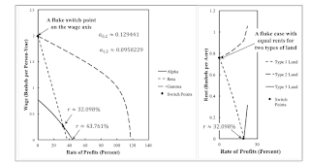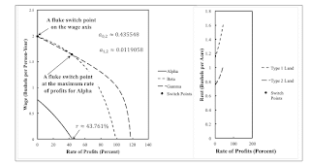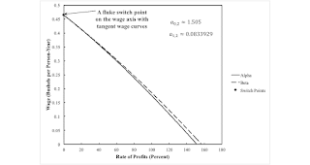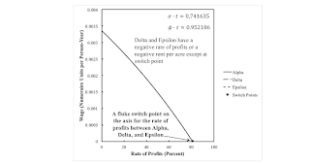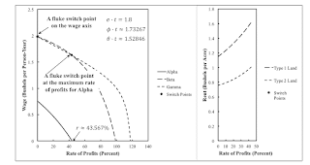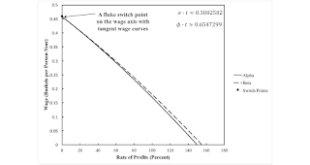Figure 1: Wage Curves and Rent for an Example of Extensive Rent This is basically an introduction to a draft research article. Maybe I have difficulty in justifying paying attention to the type of fluke points I haqve been exploring and in formally defining why they are flukes. In this post, I present a partition of a parameter space associated with an example of extensive rent. It is probably too complicated to replace this example. Anyways, I have constructed a new fluke case. Here a...
Read More »Fluke Switch Points
Exploring perturbations of four examples of fluke switch points provides a brief survey of some aspects of prices of production. The examples arise in, respectively, models of circulating capital, fixed capital, extensive rent, and intensive rent. The reverse substitution of labor, reswitching, and capital reversing, for example, are contrasted with genuine fluke cases. These posts present examples of fluke switch points. Each example is of a fluke case in at least two ways. Either two...
Read More »The Emergence Of Multiple Cost-Minimizing Techniques
Figure 1: Wage Curves and Rent for an Example of Intensive Rent This post is a rewrite of this. The analysis of the choice of technique, in my previous three posts in this series, has always been based on the construction of a wage-rate of profits frontier. Given a technology in which requirements for use can be satisfied, prices of production for a feasible technique, including the wage, are uniquely determined by the given rate of profits. If the rate of profits is in a range where such...
Read More »An Extensive Rent Example
Figure 1: A Wage Curves and Rent for an Example of Extensive Rent This post is a rewrite of this. It is the third in a series, with the first here and the second here. The analysis of the choice of technique in models of extensive rent can be based on the construction of wage curves, even though the outer envelope does not represent the cost-minimizing technique. The orders of fertility and rentability are emphasized here. The order of fertility is defined for specified techniques, in...
Read More »Fixed Capital And The Emergence Of Reswitching
Figure 1: A Wage Frontier With A Fluke Switch Point This post is a rewrite of this, without the attempt to draw a connection to structural economic dynamics. This is the second post in a series, starting with this. A fluke example with fixed capital illustrates the emergence of the reswitching of techniques. Table 1 presents coefficients of production in a perturbation of an example from Schefold (1980). With the first process, workers, under the direction of mangers of firms, manufacture...
Read More »The Emergence Of The Reverse Substitution Of Labor
Figure 1: A Wage Frontier With Two Fluke Switch Points This post is a rewrite of this, without the attempt to draw a connection to structural economic dynamics. This post presents an example with circulating capital alone. Table 1 presents the technology for an economy in which two commodities, iron and corn, are produced. Managers of firms know of one process for producing iron and two for producing corn. Each process is specified by coefficients of production, that is, the required...
Read More »Reminder: Wages, Employment Not Determined By The Supply And Demand Of Labor
1.0 Introduction Over a half-century ago, economists reached a consensus. The model in which employment and real wages are explained by the intersection of a downwards-sloping labor demand function and a supply function is incoherent, not even wrong. This incoherence was demonstrated under the assumptions of perfect competition and of firms that have adjusted their plant and other capital inputs. I do not know what Greg Mankiw and Jonathan Gruber are doing, but it certainly is not...
Read More »On The Emergence of Multiple Cost-Minimizing Techniques
Figure 1: Wage Curves and Rent for an Example of Intensive Rent The analysis of the choice of technique has above always been based on the construction of a wage-rate of profits frontier. Given a technology in which requirements for use can be satisfied, prices of production for an eligible technique are uniquely determined by the given rate of profits. If the rate of profits is in a range where such prices are non-negative for at least one technique, one of the techniques is uniquely...
Read More »An Extensive Rent Example
Figure 1: Wage Curves and Rent for an Example of Extensive Rent The analysis of the choice of technique in models of extensive rent can be based on the construction of wage curves, even though the outer envelope does not represent the cost-minimizing technique. The orders of fertility and rentability are emphasized here. The order of fertility is the order in which different qualities of land are introduced into production as requirements for use expand. The order of rentability specifies...
Read More »Fixed Capital And The Emergence Of Reswitching
Figure 1: A Wage Frontier With A Fluke Switch Point A fluke example with fixed capital illustrates the emergence of the reswitching of techniques. Table 1 presents coefficients of production in a perturbation of an example from Schefold (1980). With the first process, workers, under the direction of mangers of firms, manufacture new machines. The remaining two processes are used to produce corn. The last process requires an input of an old machine, which is jointly produced with corn by the...
Read More » Heterodox
Heterodox

